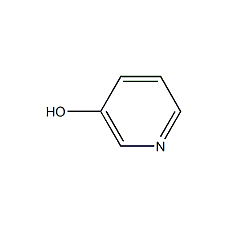
Structural formula
| Business number | 02YF |
|---|---|
| Molecular formula | C5H5NO |
| Molecular weight | 95.10 |
| label |
3-pyridinol, 3-pyridone, azabenzone, 3-Oxopyridine, 3-Pyridylalcohol, beta-Hydroxypyridine, m-Hydroxypyridine, Hydroxypyridine(3-), B-Pyridone, Aurora Ka-3075, 2(1h)-Pyridone |
Numbering system
CAS number:109-00-2
MDL number:MFCD00006378
EINECS number:205-520-3
RTECS number:UV1144050
BRN number:105699
PubChem number:24895705
Physical property data
1. Properties: colorless needle-like crystals.
2. Density (g/mL, 20℃): Undetermined
3. Relative vapor density (g/mL, air=1): Undetermined
4. Melting point (ºC): 129
5. Boiling point (ºC, normal pressure): 280-281
6. Boiling point (ºC, kPa): Undetermined
p>
7. Refractive index (D20): Undetermined
8. Flash point (ºC): 173
9. Specific rotation (ºC): Undetermined
10. Autoignition point or ignition temperature (ºC): Undetermined
11. Vapor pressure (mmHg, 20ºC ): Undetermined
12. Saturated vapor pressure (kPa, ℃): Undetermined
13. Heat of combustion (KJ/mol): Undetermined
14. Critical temperature (ºC): Undetermined
15. Critical pressure (KPa): Undetermined
16. Log value of oil-water (octanol/water) partition coefficient: Undetermined Determined
17. Explosion upper limit (%, V/V): Undetermined
18. Explosion lower limit (%, V/V): Undetermined
19. Solubility: Soluble in alcohol and water, slightly soluble in ether and benzene.
Toxicological data
1. Acute toxicity: mice intraperitoneal LD50: 1822mg/kg; mammals LD50: 900mg/kg; wild birds oral LD50: 750mg/kg;
Ecological data
This substance is slightly hazardous to water.
Molecular structure data
1. Molar refractive index: 26.22
2. Molar volume (cm3/mol): 81.0
3. Isotonic specific volume (90.2K ): 216.4
4. Surface tension (dyne/cm): 50.7
5. Polarizability (10-24cm3): 10.39
Compute chemical data
1. Reference value for hydrophobic parameter calculation (XlogP): None
2. Number of hydrogen bond donors: 1
3. Number of hydrogen bond acceptors: 2
4. Number of rotatable chemical bonds: 0
5. Number of tautomers: 3
6. Topological molecule polar surface area 33.1
7. Number of heavy atoms: 7
8. Surface charge: 0
9. Complexity: 56
10. Number of isotope atoms: 0
11. Determine the number of atomic stereocenters: 0
12. Uncertain number of atomic stereocenters: 0
13. Determine the number of chemical bond stereocenters: 0
14. Number of uncertain chemical bond stereocenters: 0
15. Number of covalent bond units: 1
Properties and stability
When encountering ferric chloride, it forms a red solution and is easily decomposed in the air. Avoid contact with oxides.
Storage method
Stored in a cool, ventilated warehouse. Keep away from fire and heat sources. Keep container tightly sealed. should be kept away from oxidizer, do not store together. Use explosion-proof lighting and ventilation facilities. It is prohibited to use mechanical equipment and tools that are prone to sparks. The storage area should be equipped with emergency release equipment and suitable containment materials.
Synthesis method
It is obtained by sulfonation, alkali fusion and neutralization of pyridine. Add fuming sulfuric acid into a dry reaction pot, add pyridine dropwise with stirring, and then add mercury sulfate. Heat to 230-240℃ and keep warm for 13-14h. Cool to 20-25°C, add ethanol, continue to cool to below 5°C, and crystallize. Filter to obtain pyridine-3-sulfonic acid. The melting point is 345°C and the yield is 62%. Add sodium hydroxide and pyridine-3-sulfonic acid into the reaction pot, melt at 160°C, raise the temperature to 220-230°C and keep it warm for 4 hours. Cool to 100°C, add water to dissolve, adjust pH to 4 with 30% hydrochloric acid, concentrate under reduced pressure, and filter to remove sodium chloride. Adjust the pH of the filtrate to 8-9 with saturated sodium carbonate, cool, filter, and dry to obtain crude 3-hydroxypyridine with a yield of 64%. Recrystallize from toluene to obtain a fine product with a melting point of 126-128°C, a content of 98%, and a purification yield of 80%.
Purpose
Used in organic synthesis, medicine and dye preparation

 微信扫一扫打赏
微信扫一扫打赏

